Using HHPred for Protein Analysis
Overview
QuestionsObjectives
Requirements
Time estimation:
Agenda
Background: Using Protein Structure Prediction Tools to Predict Function
- Protein Structure Prediction
- Tools That Predict Protein Structure
- Caveats
Using & Interpreting HHPred with Caution
Annotation in Apollo Based on HHPred Results
- Directions on Naming the Protein
- What to Include in the Notes
Background: Using Protein Structure Prediction Tools to Predict Function
Protein Structure Prediction
There are a variety of tools developed to predict protein structure using the amino acid sequence. Often these rely on protein alignments and sometimes threading through the published structures of similar proteins. These are incredibly computationally intensive tasks. For this reason, online servers typically limit the number of prediction jobs that can be run at a time, and we do not host them here in the CPT Galaxy. It is not very useful to run protein sequence through these tools if you have high confidence of its function based on high-confidence similarity to phage or bacterial proteins of known function, or with good domain hits and reasonable genomic context. Sometimes, the predicted structures, or similarity to structures of proteins with known function, is helpful when making a novel phage protein functional prediction, but their use and interpretation should be done judiciously.
Tools That Predict Protein Structure
A few of the tools in the field are:
Relevant Reading
Each of the above tools is described by papers linked on their sites. This training material discussed HHPred. There are two important papers that should be consulted for additional information on HHPred. A Completely Reimplemented MPI Bioinformatics Toolkit with a New HHpred Server at its Core. J Mol Biol. 2017 Dec 16. and a protocol for using HHPred here: Protein Sequence Analysis Using the MPI Bioinformatics Toolkit
Caveats
The outputs from these tools are predictions with varying levels of accuracy. At their very best, structure prediction serves to generate hypotheses that can be tested experimentally. Similar to cautions that apply to domain-swapping (as discussed with regard to InterPro domain hits), pay careful attention to each hit. Small regions of predicted structural similarity and low-confidence in the predictions should be considered weak evidence, and not used for confident structural prediction. Be conservative in your use of protein structural prediction tools for functional prediction. Use it last and be most suspicious of its results.
Using & Interpreting HHPred with Caution
Below, we offer an abbreviated and targeted guide for using HHPred prediction in the context of phage genome annotation in CPT Apollo. For a detailed protocol written by the tool developers, including helpful information about the confidence in interpretation, see their paper Protein Sequence Analysis Using the MPI Bioinformatics Toolkit on Pubmed or the journal website.
Input - Getting your protein sequence from Apollo to HHPred
Right-click on a feature and select Get Sequence. Copy the amino acid sequence. Including the genomic coordinates is useful as well. Navigate to the HHPred tool. Paste the protein sequence in FASTA format into the query box. To do this, add a ‘>’, then paste the copied sequence with the feature coordinates as the header and all the amino acids on a new line.

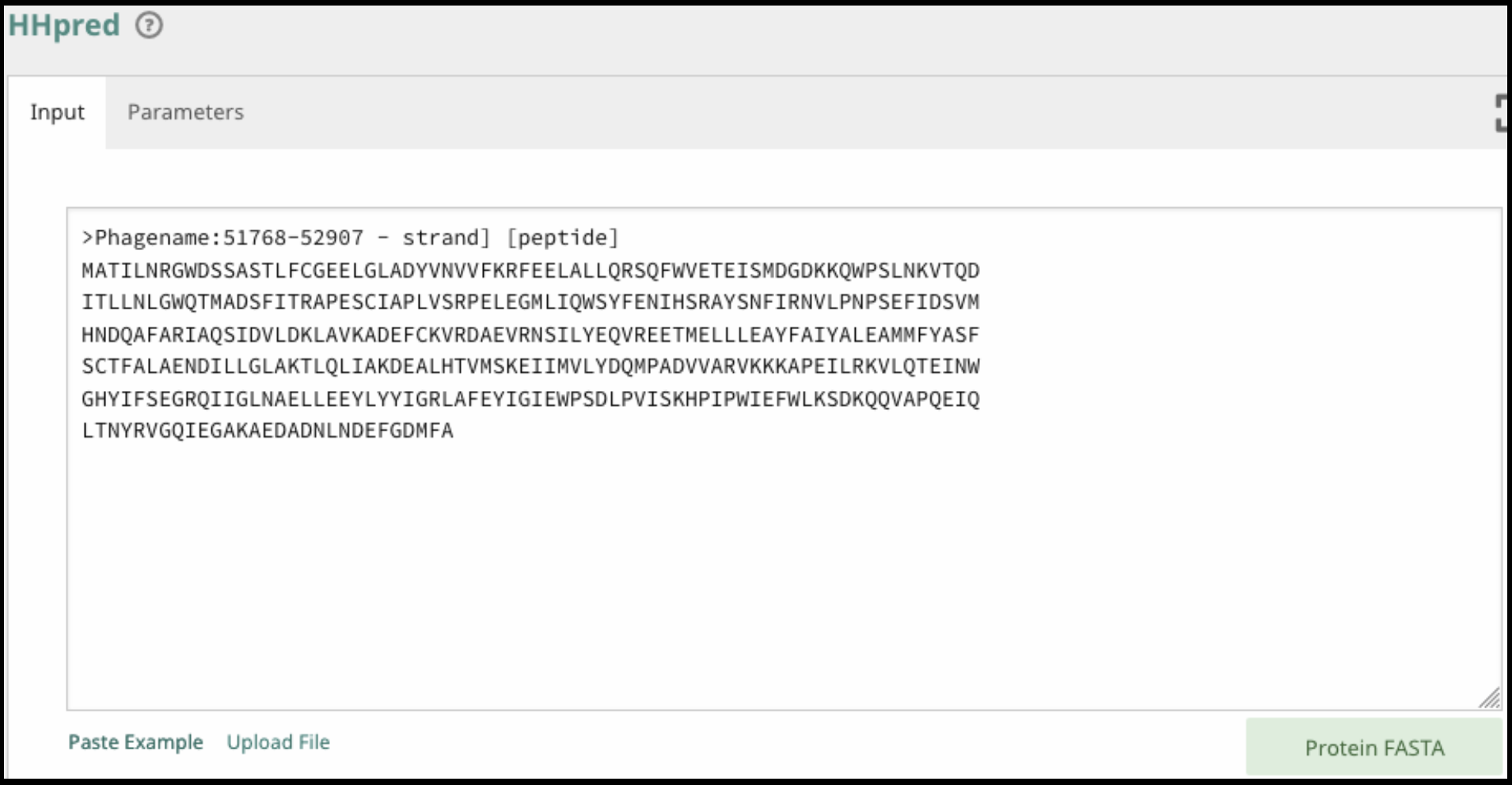
Parameters to run the tool
Use the standard parameters, unless you have read the help documentation and have good reason to change the defaults. Click Submit Job after it detects that you have entered your protein sequence in FASTA format. Jobs can take from 1-30 minutes typically.
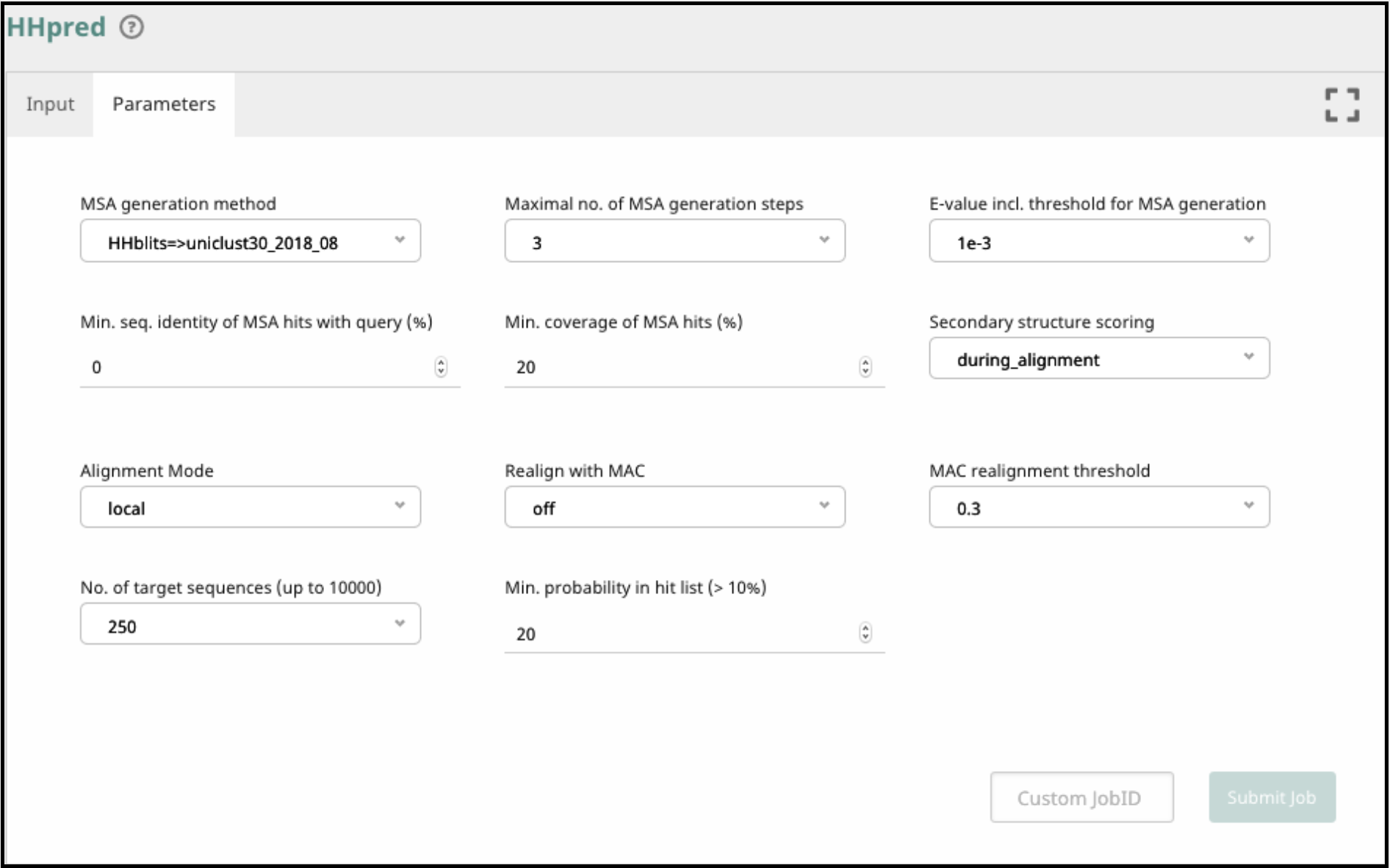
Note that…
Jobs are stored for 3 weeks. If you want to come back to these analyses in another browser or session, write down the job ID.

Looking at the results
The results are displayed in the browser under several new tabs. The most interesting results are usually in the Results tab and are divided into three parts: Visualization, Hits, and Alignment.
Under Visualization, colored boxes show where there is alignment of the query protein to hits in the structure database. The color indicates probability score, where red is best and blue is worst. Pay close attention to how much of the query protein is similar to these hits. A good hit that covers a small percentage of the query may be enough to give you a reasonable functional prediction. A low probability hit over a majority of the protein, on the other hand, may not be enough to allow confident prediction of the function.
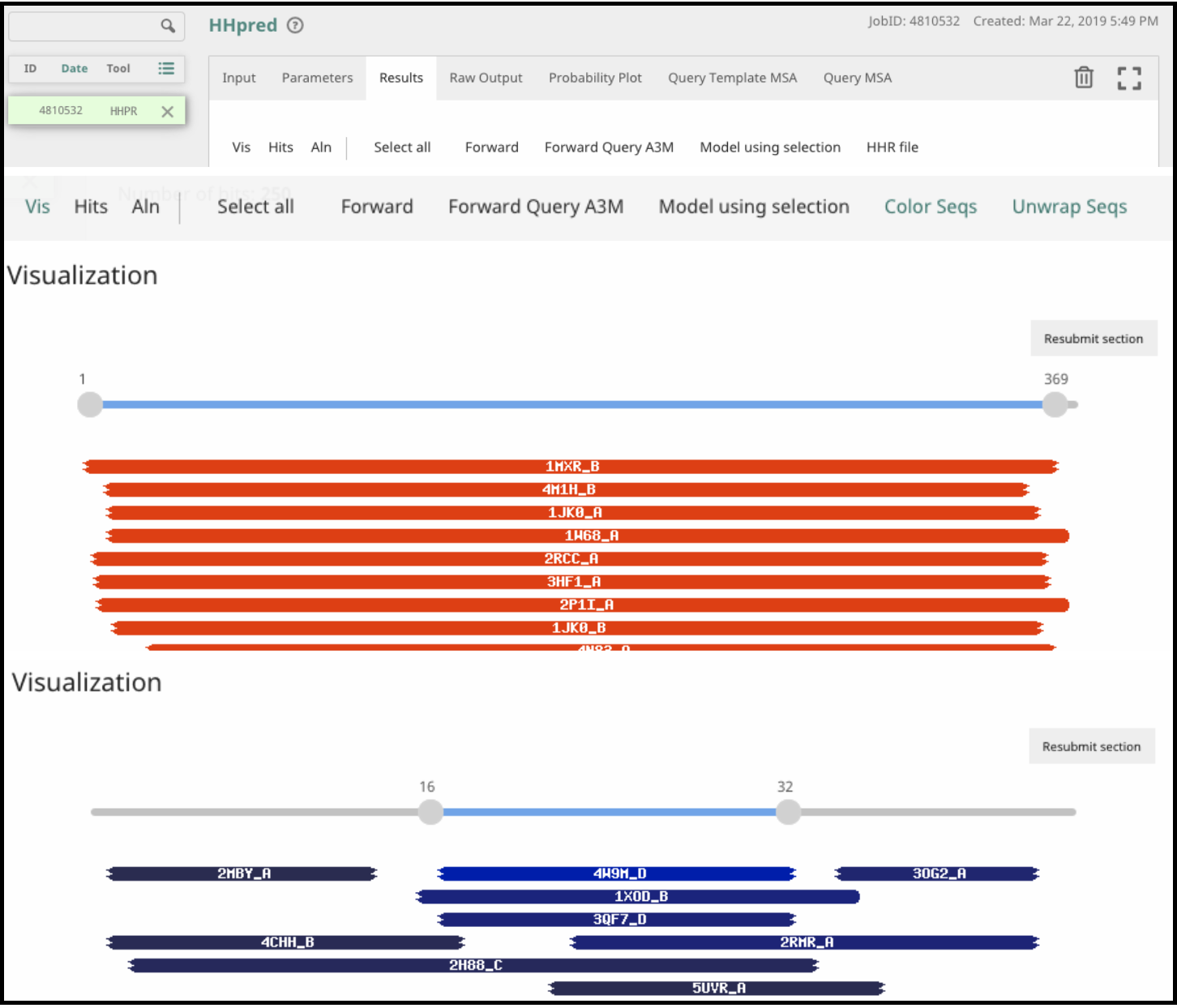
Under Hits, the proteins that align, with their probability, coverage, and external links to their Protein Data Bank entry (Under Hit column) are listed.
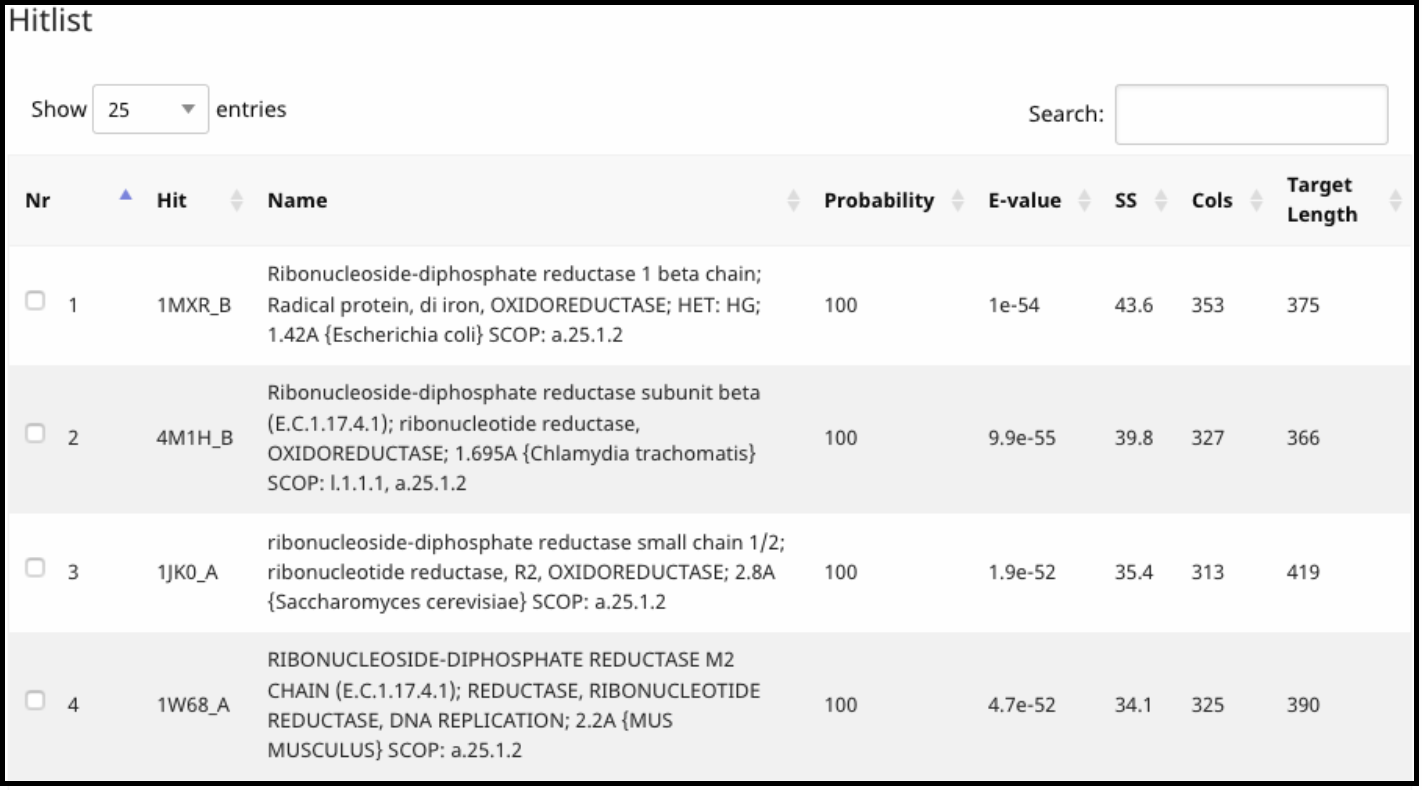
Under Alignment, a detailed alignment between the query and target is given.
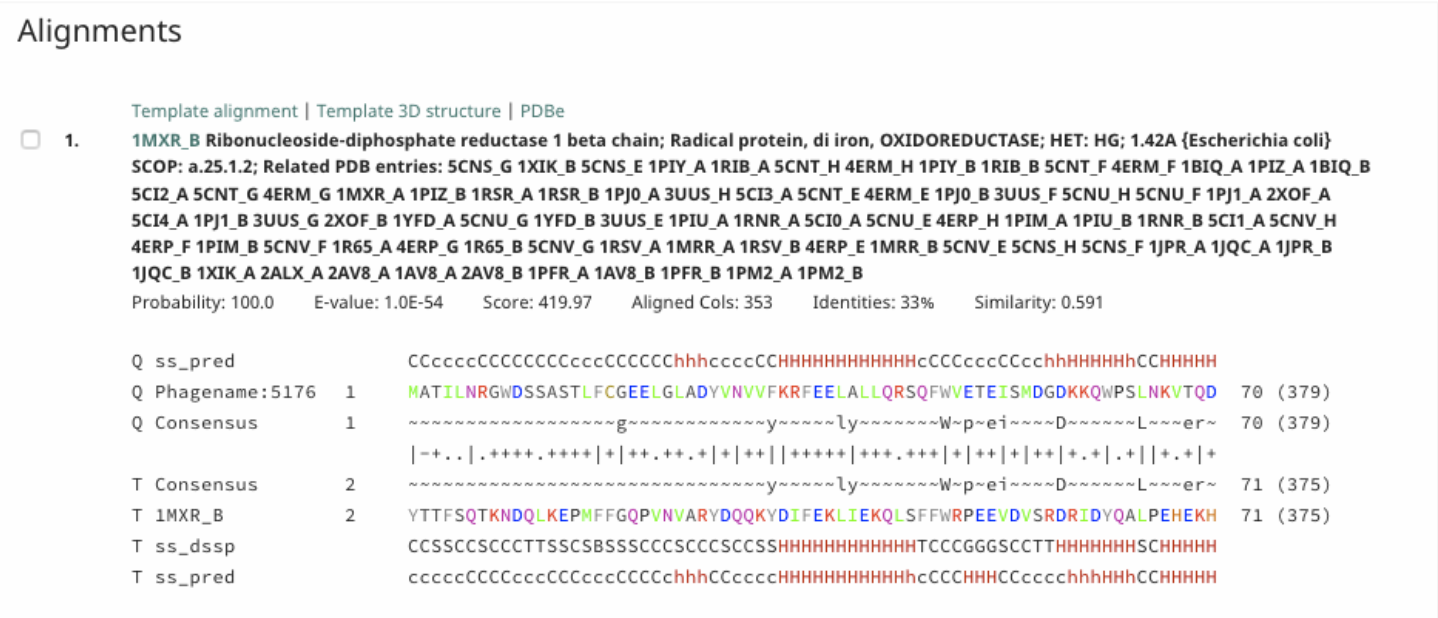
Note that…
Probability takes into consideration secondary structure, and uses the weighted conservation of amino acids at each position for homology determination for prediction.
E-value indicates how many chance hits with a better score than this would be expected in a fully unrelated database (I. E.: Smaller is better, and smaller than one is absolutely required).
Alignment Guide
In the alignments, the amino acids are colored based on their physio-chemical properties (E. G.: positive charge = red, negative charge = blue, aliphatic = green).
Query-related rows start with ‘Q’ and target-related ones with ‘T’.
While ss_pred indicates secondary structure (SS) states as predicted by PSIPRED, ss_dssp indicates SS states calculated using DSSP from known structures (e = beta-strand, h = alpha-helix).
Consensus rows show the conservation pattern of residues in the query and target alignments.
Questions About Interpreting Results?
For more comprehensive definitions of symbols and interpreting the output, go to the documentation at https://github.com/soedinglab/hh-suite/wiki and search: HMM-HMM pairwise alignments
Sorting through results critically
HHPred on hypothetical proteins
- 95% probability = in the bag
- 50% probability = should be checked for reasonableness
- 30% probability AND in the top three hits = should be checked for reasonableness
Questions About Interpreting Results?
For answers to questions about looking at the results and more (“What is the meaning of the symbols (+.-|~)?” or, “What is the significance of upper vs. lowercase letters in both the consensus and ss_pred lines?”), see this document: https://github.com/soedinglab/hh-suite/wiki
What HHPred developers have to say about checking homology. Go to the documentation at https://github.com/soedinglab/hh-suite/wiki and search: How can I verify if a database match is homologous? Also see the Commentary section in the detailed protocol written by the tool developers on Pubmed or the journal website.
Annotation in Apollo Based on HHPred Results
Directions on Naming the Protein
A Reminder of Naming Guidelines
It is imperative to follow suit with the UniProt and NCBI international naming conventions. It allows for standardization and consistency in naming proteins, subsequently aiding data retrieval and improving communication. Follow the convention for capitalization and hypothetical protein naming.
What to Include in Notes
HHPred (at minimum):
- Reference to HHPred prediction
- Organism name, protein name, and Protein Data Bank IDs of hits (looks something like: 3NJX_A)
- Probability score and general description of coverage
- Example note: HHPred predicted structural similarity at 99 probability to phage T4 portal protein gp20 Protein Data Bank entry 3JA7_I over most of protein
Congratulations on successfully completing this tutorial!
Help us improve this content!
Please take a moment to fill in the Galaxy Training Network Feedback Form. Your feedback helps us improve this tutorial and will be considered in future revisions.